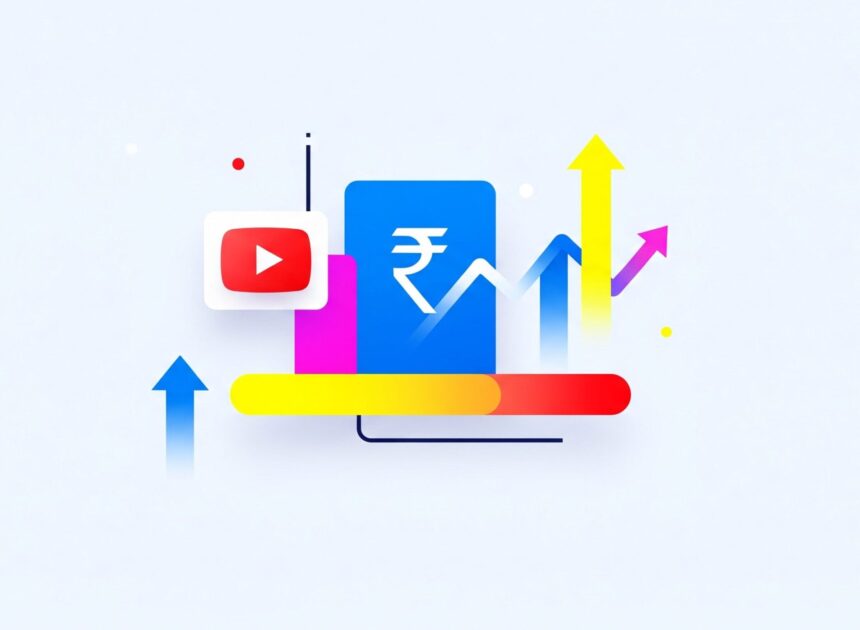YouTube isn’t just a video platform in India with over 491 million active users; it’s a digital universe. The question for businesses isn’t if their audience is on YouTube, but how to reach them effectively. Are you tapping into this massive audience, or are you held back by the fear of unknown advertising costs? Many businesses understand YouTube’s potential but hesitate, lacking clarity on the actual financial investment required.
This guide is here to demystify the YouTube advertising cost in India for 2025. We’ll break down the pricing models, explore the key factors that influence your spending, and show you how to set a realistic budget for maximum impact and return on investment.
Why YouTube is an Unmissable Platform for Indian Marketers in 2025
Before we dive into the numbers, it’s crucial to understand why YouTube advertising is such a powerful tool in the Indian market. The platform’s dominance is built on two key pillars: unparalleled reach and evolving viewing habits.
Unmatched Reach: Connecting with India’s 491M+ Digital Audience
The sheer scale of YouTube in India is staggering. Reaching nearly half a billion users means you have access to a diverse audience spanning countless demographics, locations, and interests. Whether you’re a local bakery in Bangalore or a national e-commerce brand, your potential customers are on YouTube, actively searching for content, entertainment, and solutions to their problems. This massive, engaged user base makes it an essential channel for building brand awareness and driving sales.
The Mobile-First and Connected TV (CTV) Landscape
India is a mobile-first nation, and video consumption reflects this trend. The majority of YouTube views come from smartphones, making it a prime channel to reach people on the go. Simultaneously, the rise of Connected TV (CTV) is changing how families consume content, bringing YouTube from the small screen to the living room TV. This dual-screen dominance allows advertisers to create integrated campaigns that reach users across multiple touchpoints in their day.
Understanding the Core Pricing Models
YouTube doesn’t have a one-size-fits-all price tag. The cost is determined by how you choose to pay for your ads, based on your specific campaign goals. Understanding these core pricing models is the first step to controlling your budget.
Cost-Per-View (CPV)
With the CPV model, you pay only when someone watches your video ad. A “view” is typically counted when a user watches at least 30 seconds of your ad (or the entire ad if it’s shorter) or interacts with it by clicking a link. This model is ideal for campaigns focused on engagement and brand consideration, as you’re only paying for genuinely interested viewers.
Cost-Per-Mille (CPM)
CPM stands for Cost-Per-Mille, or cost per 1,000 impressions. An impression is counted each time your ad is shown on a screen. You pay for every thousand times your ad appears, regardless of whether it’s watched or clicked. CPM is the preferred model for large-scale brand awareness campaigns where the primary goal is to maximize visibility and reach as many people as possible.
Cost-Per-Action (CPA)
Also known as Cost-Per-Acquisition, the CPA model means you pay only when a user takes a specific, desired action after seeing your ad. This action could be making a purchase, filling out a lead form, or downloading an app. CPA is a performance-focused model, making it perfect for campaigns where the main objective is to drive direct conversions and leads.
What is the Average YouTube Ads Cost in India?
Now for the question on every marketer’s mind: what does it actually cost? While a precise number is impossible to state due to many variables, we can look at typical industry benchmarks to get a clear picture.
A Look at Typical CPV and CPM Ranges
Based on recent data and industry trends in India, you can expect the following average ranges:
- Average Cost-Per-View (CPV): ₹0.30 to ₹0.90
- Average Cost-Per-Mille (CPM): ₹70 to ₹250
Remember, these are just starting points. A highly competitive industry or a very specific audience target could push these numbers higher, while a broad awareness campaign might see costs on the lower end.
Unpacking the Mobile YouTube CPM in India: Why ₹30 – ₹70 is a Key Benchmark
When focusing specifically on mobile placements, which constitute the bulk of viewership, the youtube cpm in India can often be more competitive. For certain ad formats and broad targeting, it’s not uncommon to see mobile CPMs in the ₹30 to ₹70 range. This benchmark is crucial for advertisers looking to maximize reach on a tighter budget, as focusing on mobile-only delivery can significantly lower the overall cost per thousand impressions.
Factors That Cause Your YouTube Ads Price in India to Fluctuate
The YouTube ads price in India is not static. It’s a dynamic figure influenced by a live auction system. Your final cost can vary from one day to the next based on a multitude of factors, which we will explore in detail below.
Key Factors That Determine Your Final YouTube Advertising Cost in India
Think of your ad cost as a recipe with several ingredients. The combination and quality of these ingredients will determine the final price. Here are the most significant factors you need to control.
Ad Format
The type of ad you choose plays a huge role in your costs.
- Skippable In-Stream Ads: These are the most common format. Since users can skip after 5 seconds, CPV is a popular pricing model.
- Non-Skippable In-Stream Ads: These ads (up to 15 seconds) must be watched in full. They are sold on a CPM basis and tend to have a higher cost but guarantee your message is seen.
- Bumper Ads: These are short, 6-second, non-skippable ads sold on a CPM basis. They are cost-effective for delivering a quick, memorable message.
- In-Feed Video Ads: These appear in search results and on the YouTube homepage. You pay on a CPV basis when someone clicks the thumbnail to watch.
Audience Targeting
The more specific your audience, the higher the potential cost, but also the higher the potential ROI.
- Demographics: Targeting by age, gender, and parental status.
- Location: Targeting users in specific cities, states, or even pin codes.
- Interests: Reaching people based on their passions and hobbies (e.g., “cricket fans”).
- Intent & Remarketing: Targeting users actively searching for products you sell or who have previously interacted with your website or channel. This is often more expensive but highly effective.
Your Bidding Strategy and Campaign Objective
Your campaign goal (e.g., awareness, leads, sales) tells Google Ads what to optimize for. A “Maximize Conversions” bid strategy will behave differently and cost more per interaction than a “Maximize Reach” strategy, which focuses on the lowest possible CPM.
Ad Quality Score and Creative Relevance
Google assigns a Quality Score to your ads. A high-quality, relevant video creative that resonates with your target audience will lead to higher engagement rates. In turn, YouTube’s algorithm rewards you with a better score, which can result in a lower CPV and better ad placements. A poor-quality, irrelevant ad will cost you more to show.
Industry Competition and Seasonality
You are bidding against other advertisers for the same audience. During peak seasons like Diwali, the Cricket World Cup, or major e-commerce sales, competition skyrockets, driving up the youtube ads cost in India. Bidding for a keyword in a highly competitive industry like finance or real estate will naturally cost more than in a less crowded niche.
How to Set a Realistic Budget for Your Campaign
Understanding the factors is one thing; applying them to a budget is the next step. Here are some sample scenarios to help you plan.
Starting Small: A Sample Budget for a Local Business
Imagine a local bakery in Pune wanting to promote a new cake menu.
- Goal: Drive local awareness and website traffic.
- Targeting: Users aged 25-55 within a 15km radius of the store, interested in “desserts” and “baking.”
- Strategy: A simple CPV campaign with skippable in-stream ads.
- Sample Budget: A starting budget of ₹500 – ₹700 per day (₹15,000 – ₹21,000 per month) would be a realistic starting point to gather data and see initial results.
Scaling Up: Budgeting for a Regional E-commerce Brand
Consider a fashion brand that sells and delivers across South India.
- Goal: Drive online sales and conversions.
- Targeting: Users in major southern cities, remarketing to past website visitors, and targeting audiences interested in competing brands.
- Strategy: A mix of CPV for top-of-funnel and CPA for conversion-focused campaigns.
- Sample Budget: A more aggressive budget of ₹2,000 – ₹5,000 per day (₹60,000 – ₹1,50,000 per month) would be needed to reach a larger audience and optimize for sales.
Going National: Estimating Costs for a Brand Awareness Campaign
Think of a new smartphone brand launching across India.
- Goal: Maximize reach and brand recall.
- Targeting: Broad demographic targeting (e.g., males aged 18-35) across the entire country.
- Strategy: A CPM-based campaign using a mix of non-skippable and bumper ads for maximum visibility.
- Sample Budget: National campaigns require significant investment. Budgets could easily start from ₹20,000+ per day (₹6,00,000+ per month) to make a meaningful impact at this scale.
4 Pro Tips to Optimize Your Spend and Maximize ROI
Simply spending money isn’t enough. The key to success is spending it wisely. Here are four expert tips to get the most out of every rupee.
Tip 1: Nail Your Targeting to Avoid Wasted Ad Spend
The fastest way to lose money is by showing your ads to the wrong people. Be ruthless with your targeting. Use negative keywords, exclude irrelevant demographics, and layer different targeting options to create a highly specific audience profile. The more precise your targeting, the less money you’ll waste on uninterested viewers.
Tip 2: A/B Test Your Video Creatives Relentlessly
Never assume you know which ad will perform best. Always test different versions of your video creative.
- Test different video hooks in the first 3-5 seconds.
- Test different thumbnails to improve click-through rates.
- Test different calls-to-action (CTAs) to see what drives more conversions.
- Test different ad lengths and formats.
Tip 3: Leverage Remarketing for Higher Conversion Rates
Remarketing—showing ads to users who have already visited your website or engaged with your channel—is one of the most cost-effective strategies. These users are already familiar with your brand and are much more likely to convert. Create dedicated campaigns with tailored messaging for this warm audience to achieve a higher ROI.
Tip 4: Monitor Placement Reports to Exclude Irrelevant Channels
Your ads don’t just show up on a generic “YouTube.” They appear on specific channels and videos. Regularly check your Placement Reports in Google Ads to see exactly where your ads are being displayed. If you find your ads are appearing on low-quality, irrelevant, or non-brand-safe channels (like children’s cartoon channels for a B2B product), add them to your exclusion list immediately to stop wasting your budget.
Conclusion
Navigating the YouTube advertising cost in India doesn’t have to be intimidating. While there’s no fixed price, you are in complete control of the variables. By understanding the core pricing models like CPM and CPV, meticulously managing influencing factors like targeting and ad creative, and starting with a realistic budget, you can unlock the immense potential of India’s largest video platform. The opportunity to connect with millions of potential customers is unparalleled; success lies in a smart, data-driven strategy.
Ready to launch your first campaign and harness the power of YouTube? Start planning your 2025 YouTube advertising strategy today, or contact our experts for a personalized quote to get your brand in front of the right audience.







